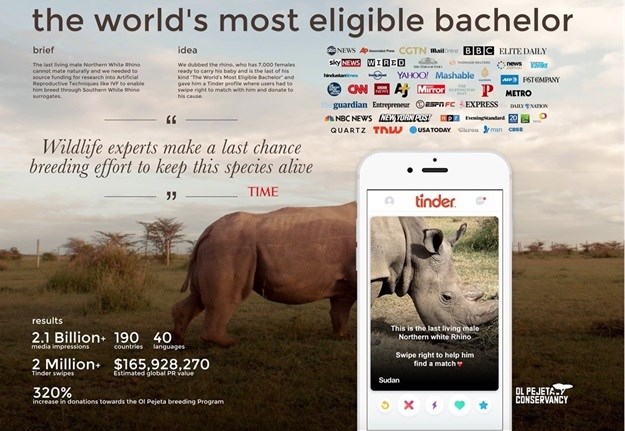APA results: Kenya's thriving advertising industry

Kenya’s internet advertising market was worth $120 million last year, compared to $65 million in Nigeria and mobile revenue accounted for 94% of the total. But many agencies are not paying enough attention to trends in the digital sphere – which is being driven mainly by rapid growth in mobile internet access.
This year the internet is expected to overtake newspapers as the main source of advertising revenue, although it will still rank third behind radio and TV, according to a 2017 survey by PwC. But it is set to double in the five years leading to 2021, with revenues from the industry overall rising by 34%.
“The good thing is we are seeing movement towards social media and digital campaigns, but there is room for more spending and more focus,” says Monty Dhariwal, the MD at Express DDB in Nairobi and co-ordinator of the country’s Association of Practitioners in Advertising (APA).
The World’s Most Eligible Bachelor
Ogilvy Africa grabbed the global limelight in April this year with a personal ad on the dating app Tinder, presenting the last northern white male rhino as ‘the World’s Most Eligible Bachelor’ in order to raise money for a breeding programme at Ol Pejeta Conservancy in Kenya.
Within a week, it had garnered two million Tinder swipes in 190 countries and raised $160,000 dollars in donations. It scooped up five awards at Africa’s regional showcase, the Loeries, and three awards at the Cannes Lions Festival, and made headlines on top TV news outlets including CNN, the BBC and Al-Jazeera.
Industry executives said the campaign was a prime example of how Kenyan creatives can successfully target digital and social media. “We decided to take a different approach – instead of making the subject of rhino conservation sad and serious, we made it fun,” says Ogilvy Africa CEO Mathieu Plassard.
“It was a complete team effort – we’re always looking at ways of innovating, especially in the social and digital space, bringing fresh ideas through the use of technology.”
Research shows that advertisers allocated only 8% of their budgets to digital media in 2015, while Kenyans spent 22% of their media time online. Globally, the share of media budgets allocated to digital channels is steadily increasing – it rose to 43% last year from 38% in 2015.
Untapped space in the creative field
The time which people will spend on their devices will of course increase – according to the Connected Consumer Survey 2016, half of Kenyans used the internet in 2016, up from 45% in 2014 and well above the African average of 25%. It estimates that 44% of Kenyans now use a smartphone, compared with just 27% in 2014.
Data from Google also shows that Kenyans spend more time watching videos – in 2016 there was a monthly average of 7.5 million U-tube views in the country compared with 2.9 million in Nigeria and just 1.0 million in South Africa.
“The current approach in our industry is to adapt billboard, print, or TVC for digital by cutting it down, resizing it and so on. This is not enough – we need to be developing interactive creative content for the digital space, in formats that work on mobile and on the go,” says Waithera Kabiru, digital marketing specialist at Coca-Cola in Nairobi.
She acknowledges that while the growth of digital media usage in Kenya is significant, some forms of traditional media are still relevant to get the mass reach or brand awareness that most products require. The trend that will continue to grow is to take on an integrated marketing approach where TV, radio, digital, experiential and PR all work together, she adds.
“We have seen the growing use of gifs, video, and boomerangs but not enough creative executions of these formats. We also need multiple creative formats for programmatic advertising, and for performance marketing. This is a largely untapped space in the creative field,” she says.
Shortage of skilled talent
Jason Nartey, an experienced creative director who plans to set up his own agency in Ghana, says that there is a shortage of skilled talent. “We need more specialists – in this industry it’s not good to be a jack of all trades and master of none,” he maintains.
Dhariwal points out that one of the challenges in Kenya is that there is no technical institution which can foster the development of skills in graphics or design for advertising. “It’s all self-taught so it gets limiting – local talent requires mentoring,” he says.
Plassard believes that one of the positive trends in Kenyan advertising is that the industry has developed a more competitive spirit. “People are less comfortable with the status quo – everyone is looking now at ways to push the envelope, to make a good idea into an excellent one,” he says.
Competing for awards is part of the process. Last year, the Loeries partnered with the APA to relaunch the Kenyan APA awards after a 12-year hiatus and the event took place again this year on 1 December.
“It’s all very encouraging for our local creative industry – there is now a platform for them to showcase their work,” Dhariwal says.
Related
5 Gerety Awards Grand Jury members for 2025 from the African continent 3 Dec 2024 South Africa's Promise Agency strikes Gold at LIA for The Vluit Project 17 Oct 2024 African marketers gear up for AMC’s 3rd annual awards in Mombasa 4 Sep 2024 Kenya must compensate family of slain Pakistan journalist, court rules 9 Jul 2024 Standard Bank, MiDA in $700m green housing deal 28 May 2024 SA doctors make up to 40 times more than those in Kenya and Nigeria 5 Apr 2024


























